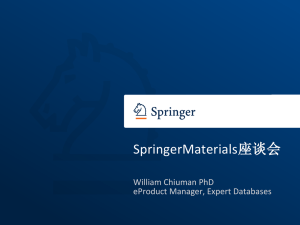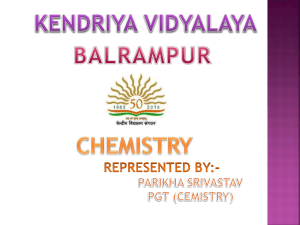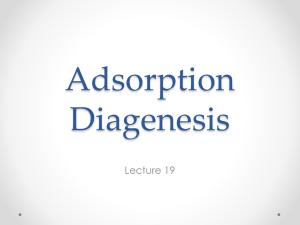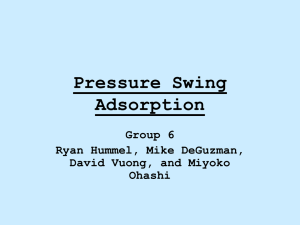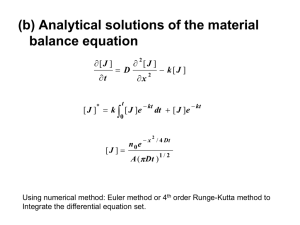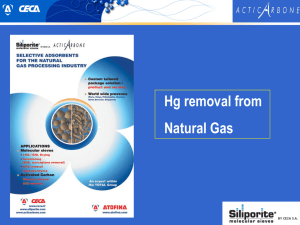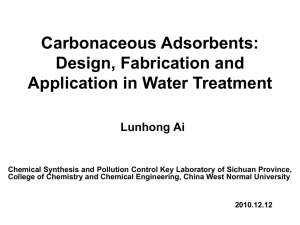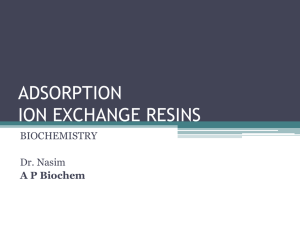Evaluation of Methylene Blue Removal From Water by Adsorption
advertisement
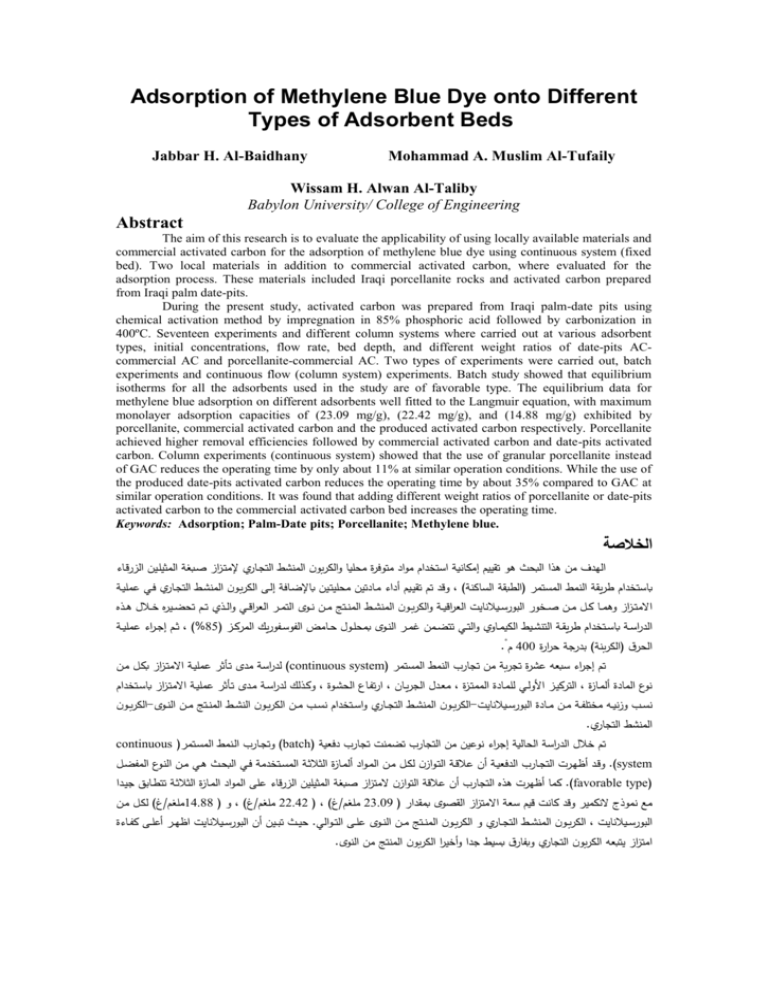
Adsorption of Methylene Blue Dye onto Different Types of Adsorbent Beds Jabbar H. Al-Baidhany Mohammad A. Muslim Al-Tufaily Wissam H. Alwan Al-Taliby Babylon University/ College of Engineering Abstract The aim of this research is to evaluate the applicability of using locally available materials and commercial activated carbon for the adsorption of methylene blue dye using continuous system (fixed bed). Two local materials in addition to commercial activated carbon, where evaluated for the adsorption process. These materials included Iraqi porcellanite rocks and activated carbon prepared from Iraqi palm date-pits. During the present study, activated carbon was prepared from Iraqi palm-date pits using chemical activation method by impregnation in 85% phosphoric acid followed by carbonization in 400ºC. Seventeen experiments and different column systems where carried out at various adsorbent types, initial concentrations, flow rate, bed depth, and different weight ratios of date-pits ACcommercial AC and porcellanite-commercial AC. Two types of experiments were carried out, batch experiments and continuous flow (column system) experiments. Batch study showed that equilibrium isotherms for all the adsorbents used in the study are of favorable type. The equilibrium data for methylene blue adsorption on different adsorbents well fitted to the Langmuir equation, with maximum monolayer adsorption capacities of (23.09 mg/g), (22.42 mg/g), and (14.88 mg/g) exhibited by porcellanite, commercial activated carbon and the produced activated carbon respectively. Porcellanite achieved higher removal efficiencies followed by commercial activated carbon and date-pits activated carbon. Column experiments (continuous system) showed that the use of granular porcellanite instead of GAC reduces the operating time by only about 11% at similar operation conditions. While the use of the produced date-pits activated carbon reduces the operating time by about 35% compared to GAC at similar operation conditions. It was found that adding different weight ratios of porcellanite or date-pits activated carbon to the commercial activated carbon bed increases the operating time. Keywords: Adsorption; Palm-Date pits; Porcellanite; Methylene blue. الخالصة الهدف من هذا البحث هو تقييم إمكانية استخدام مواد متوفرة محليا والكربون المنشط التجاار ممتازاز غاباة المييلاين الزر اا ملياة و د تم تقيايم ددا ماادتين محليتاين بامةاافة إلار الكرباون المنشاط التجاار فا، )باستخدام طريقة النمط المستمر (الطبقة الساكنة ال ار يااة والكربااون المنشااط المنااتو ماان نااوع التماار ال ار ا والااذ تاام تحةااير خااي هااذ مليااة ياام إج ا ار، )%85( ال وس ا وري المركااز االمت ازاز وهمااا كااخ ماان غااخور ال ورسااييناي الد ارسااة باسااتخدام طريقااة التنشاايط الكيماااو والت ا تتةاامن وماار النااوع بمحلااو حااام .° م400 الحرق (الكربنة) درجة ح اررة ) لدراسة مدع تاثير ملياة االمتازاز بكاخ مانcontinuous system( تم إج ار سب ه شرة تجربة من تجارب النمط المستمر وكاذل لد ارساة مادع تاثير ملياة االمتازاز باساتخدام، ارت ااع الحشاوة، م اد الجرياان، التركياز الولا للماادة الممتازة، نوع المادة دلماازة الكربااون-الكربااون المنشااط التجااار واسااتخدام نسااب ماان الكربااون النشااط المنااتو ماان النااوع- نسااب وزنيااه مختل ااة ماان مااادة ال ورسااييناي . المنشط التجار continuous () وتجاارب الانمط المساتمرbatch( تجارب دف ية تم خي الدراسة الحالية إج ار نو ين من التجارب تةمن و اد دههار التجااارب الدف ياة دن ي ااة التاوازن لكااخ مان الماواد دلماازة الييياة المسااتخدمة فا البحااث ها ماان الناوع الم ةااخ.)system لر المواد الماازة الييياة تتطاا ي جيادا كما دههر هذ التجارب دن ي ة التوازن المتزاز غباة المييلين الزر ا.)favorable type( غ) لكاخ مان/ملام14.88 ( و، )غ/ ملام22.42 ( ، )غ/ ملام23.09 ( يم س ة االمتزاز القغوع بمقدار اههاار د لاار ك ااا ة مع نموذج النكمير و د كان حيااث ت ااين دن ال ورسااييناي. الكربااون المنشااط التجااار و الكربااون المنااتو ماان النااوع لاار الت اوال، ال ورسااييناي .امتزاز يتب ه الكربون التجار وب ارق بسيط جدا ودخي ار الكربون المنتو من النوع ماود االمتازاز دال من الكربون المنشاط التجاار فا الح ي دن استخدام ال ورسييناي دما تجارب النمط المستمر فقد ين ينماا اساتخدام الكرباون المناتو مان الناوع ادال. فقط ند ن س هروف التشاايخ%11 يؤد إلر تقليخ زمن التشايخ ل مود االمتزاز نسبة للكربااون . ند ن س هروف التشايخ% 35 مود االمتزاز فيؤد إلر تقليخ زمن تشايخ ال مود نسبة إلاار مااود الحشااو اليا ا من الكربون المنشط التجار ف ) ماان مااادة ال ورسااييناي% 15 ، % 12 ، % 10( وجااد دن إةااافة نسااب وزنيااه مختل ااة مان ال ورساييناي% 30 دماا إةاافة. ) لار التاوال% 30 و، % 28 ، % 18( يؤد إلر زيادة زمن التشايخ ل ماود االمتازاز نسابة ، % 12 ، % 10( كنسابة وزنيااه إلاار مااود الحشااو فيسا ب نقغاان زماان تشااايخ ال مااود ليغاابن ا ااخ مماا كااان ليااه نااد إةااافة النسااب إال دن مود الحشو ف هذ الحالة بق ي مخ بك ا ة امتزاز وزمن تشايخ د لر بقلياخ مناه فا حالاة اساتخدام الكرباون التجاار، )% 15 ماان الكربااون المنشااط المنااتو ماان النااوع إلاار مااود الحشااو اليا ا . بم رد وبدون إةافة ال ورسييناي )% 12 و% 10( إن إةافة نسب وزنيه مختل ة وفا حالاة زيااادة النسابة المةااافة ماان. لار التاوال% 22 و% 10 للكرباون التجااار يسا ب زيااادة زمان التشااايخ ل مااود االمتازاز نساابة وهااذا مااا يج ااخ، لاار الت اوال% 28 و% 5 فااان ذل ا يااؤد إلاار تقليااخ زماان التشااايخ نساابة% 17 و% 15 الكربااون المنااتو إلاار . ملية االمتزاز وير ك و ة بالمقارنة مع استخدام الكربون المنشط التجار بم رد 1. Introduction Dyes are widely used in textile, paper, plastic, food and cosmetic industries. The wastes coming from these industries can effect on our atmosphere causing pollution. The level of pollutants even in very low concentration is highly visible and will affect aquatic life as well as food web. Many dyes are difficult to degrade. They are generally stable to light, oxidizing agents and are resistant to aerobic digestion. Hence, contaminations due to dyes pose not only a severe public health concern, but also many serious environmental problems because of their persistence in nature and non biodegradable characteristics (Hajira et al., 2008). Fruit stones are appropriate raw materials for the production of activated carbons. The use of these materials as adsorbents of inorganic and organic pollutants from water is due to their unique versatility resulting from their high surface area, porous structure, high adsorption capacity, and surface chemical nature, which can be appropriately modified by physical and chemical treatments to enhance the extent of a given adsorption process (Zoulikha M. and Fatima A., 2008). The use of adsorption contacting systems for industrial and municipal wastewater treatment has become more prevalent during recent years (Babu and Gupta, 2004). The most widely used adsorbents are activated carbon, activated alumina, activated boxite, silica gel, and polymers (Nonhebal, 1972). 2. Importance of the Study The commercially available activated carbons are still considered expensive. This is due to the use of non-renewable and relatively expensive starting material such as coal, which is unjustified in pollution control applications (Tan I.A.W. et al., 2007). Therefore, The advantage of using agricultural by-products such as date pits as raw materials for manufacturing activated carbon is that these raw materials are renewable and potentially less expensive to manufacture, in addition to the fact that Iraq is one of the leading countries engaged in growing palm-date trees. On the other hand, Iraqi siliceous rocks (Porcellanite) are abundantly and naturally available in the western region of Iraq. Furthermore, no studies have reported the use of Iraqi porcellanite rocks for dye adsorption from wastewater. This shows the importance of this research in utilizing locally available and cheap material for water and wastewater treatment purposes. 3. Adsorption Isotherm Models The mathematical formulation of adsorption relationships are usually expressed in terms of either Freundlich or Langmuir equations. The Freundlich equation has the general form: (Casey T., 1992 and Ludersen A., 1983). qe x / m kC1e / n Where: q e : The amount of adsorbate adsorbed per unit mass of adsorbent (mg/g) x : The mass of the adsorbate. (mg) m: The mass of the adsorbent. (mg) Ce: equilibrium concentration of the solute remaining in solution. (mg/l) K and n: are Freundlich constants. (Tan, et al., 2007). The equation which is more useful in logarithmic form is: (Martine and AlBahrani, 1979): log( qe ) log( x / m) log( k ) 1 log Ce n The Langmuir equilibrium adsorption equation has the form: (Weber W. J., 1972). qe= x/m=(Qo b Ce)/(1+b Ce) The linearization form of the equation is (Abdul-Hammed, H. M., 1996): Ce 1 1 Ce qe Qob Qo Where: Ce: The equilibrium concentration of the adsorbate (mg/l). qe: The amount of adsorbate adsorbed per unit mass of adsorbent (mg/g) Qo and b: are Langmuir constants related to the adsorption capacity and the rate of adsorption, respectively. 4. Experimental Work 4.1 Materials I. Adsorbate Methylene blue (MB) dye was chosen in this study because of its known strong adsorption onto solids, its recognized usefulness in characterizing adsorptive material (Chongrak, K., et al., 1998), and is often serves as a model compound for removing organic contaminants and colored bodies from aqueous solutions. Methylene blue is a heterocyclic aromatic chemical compound with (C16H18CIN3S, 3H2O) as molecular formula and a molecular weight of 373.9 x 10-³ kg mol-¹ (Hameed, et al., 2006). The structure of methylene blue is given in fig.(1). Fig.(1): Methylene Blue Structure (www.wikipedia.org) II. Adsorbent Three types of adsorbent were used in the present study: A. Commercial activated carbon (GAC). B. Activated carbon prepared from Iraqi Palm-date pits. C. Iraqi siliceous rocks(porcellanite). A. Commercial Activated Carbon The commercial activated carbon (GAC) was supplied by the Iraqi commercial markets. The mesh size of activated carbon used in the study was of (1mm). For pre-treatment, the activated carbon was firstly washed with distilled water and then dried in an electric oven at 120ºC overnight (Yamin, et al., 2007). B. Activated Carbon Prepared from Iraqi Palm-date Pits B.1 Palm-date Pits Date pits, also called pips, stones, kernels, or seeds form part of the integral date fruit in the order of, depending on variety and quality grade, 6-12% of its total weight. Almost any organic matter with a large percentage of carbon could theoretically be activated to enhance its sportive characteristics (Barreveld, 1993). Table (1) shows that palm-date pits contain approximately 55-56% of carbohydrates. B.2 Production of Activated Carbon from Iraqi Date pits The preparation of activated carbon from the Iraqi palm-date pits was one of the main objectives of the present study. This part of the study involved three steps for the production of activated carbon from Iraqi palm-date pits In the first step, the pits were initially boiled in a pressure cooker for three hours at three stages with one hour interval for each stage. Boiling water was substituted with fresh water at the end of each interval. When the boiling duration was less than three hours, it was observed that the boiling water was of brown color. The boiling step was carried out in order to enhance the adsorption capacity of the pits during the soaking process. Before starting the second step, the boiled pits were dried in an electric oven at 110°C for 24 hours and then crushed with hammer. The resulting particles were sieved and the particles having a size of (1mm and 0.425mm) were used in the rest of the experimental work. Table (1): Approximate Composition of Palm-date Pits (Barreveld, 1993) Component % Moisture 5-10 Protein (N×6.25) 5-7 Oil 7-10 Crude fiber 10-20 Carbohydrates 55-65 Ash 1-2 In the second step, which is soaking, the crushed pits were placed in glass containers. A concentrated phosphoric acid (85% H3PO4) was poured carefully into the containers containing the pits with an impregnation ratio of (1 g of pits impregnated in 2 ml of 85% H3PO4) at 25 ºC (Yağşi, N. U., 2004) and an impregnation time of 24 hours. At the end of the soaking time, the soaked pits were left in air for partial dryness and then dried in an oven at 120ºC for one hour. The final step adopted in this part of the study for the production of activated carbon from palm-date pits is the process of carbonization and activation. The date pits were placed on a metallic plate and subjected to an average temperature of 400°C (Omar, G., 2003) for 2 hours. Then, Pits were washed with distilled hot water until the desired pH was achieved (6.5), and then the produced activated carbon was dried in an electric oven at 120ºC overnight in order to remove any undesired moisture within the particles. C. Iraqi Siliceous Rocks (Porcellanite) Previous studies indicated that there are large amounts of Iraqi siliceous rocks (Porcellanite) at the Western Desert in the west of Iraq. The rocks occur as sedimentary layers with a thickness of (0.5 to 1) m at Traibeel, Ajthary, and Akashat regions (Mohammed I., 1993). Iraqi Porcellanite rocks have higher quality than Turkish, Algerian, and German rocks and have very similar quality to the American Lompoc desert rocks which have the highest quality (Mohammed R. and Adnan H., 1999). These rocks were brought in a big stones form, The most pure white rocks were chosen to be used in the experiments. As a pre-treatment, porcellanite rocks were crushed and sieved to get granular porcellanite with particle size of (1mm and 0.425mm) to be used in present experiments. The granular Porcellanite was then washed with distilled water and dried in an electrical oven at 120ºC overnight. It was then placed in desiccators for cooling. 5. Experimental Procedures Tow types of experiments were carried out: 5.1 Equilibrium Isotherm Experiments A stock solution of 100 mg/l of methylene blue (MB) was prepared for calibration purposes. From the stock, different concentrations of methylene blue were prepared by diluting with water. A spectrophotometer type (UV-1650 PC SHIMATZU) was used for the determination of absorbance at the predetermined maximum absorbance wavelength (λmax=664 nm) of the MB dye for different concentrations of MB subsequently. λmax was determined by performing a scan on a MB solution sample by the spectrophotometer. A calibration curve of MB concentrations versus absorbency was constructed as shown in Fig.(2). 100 ml portions of MB solution of a 0.1 kg/m³ concentration were placed in 6 conical flasks 250 ml in volume, containing different accurately weighed masses of commercial AC (0.4, 0.6, 0.8, 1, 1.2, and 1.4 gm) using an electrical four digits scale type (Sartorius BL 210S). Along with these flasks, one blank was also run. The whole set was then placed on a Wrist shaker for 24 hours at 25ºC. After this period of shaking, samples were filtered using Whatmann no.1 filter paper, in order to minimize the interference of the carbon fines with the analysis, and the filtrates were analyzed for residual concentrations of MB using a double beam UV-visible spectrophotometer at a wavelength of 664 nm. The amount of adsorption at equilibrium, qe (mg/mg), was calculated by the following equation: q e C C V O e W Where Co and Ce (mg/l) are the liquid phase concentrations of dye at the initial and equilibrium conditions, respectively. V is the volume of the solution (l) and W is the mass of dry adsorbent used (mg). In order to estimate equilibrium isotherms of the produced date pits AC and porcellanite, the same experiment mentioned above was repeated using the two materials respectively. 3.5 MB. Conc.(mg/l) = 7.52 Abs. 3 2 R = 0.995 Absorbency 2.5 2 1.5 1 0.5 0 0 5 10 15 20 25 30 MB Concentration (mg/l) Fig.(2) UV. Spectrophotometer Calibration Curve 5.2 Fixed Bed Column Experiments Experimental arrangements The schematic representation of experimental equipments is shown in Fig.(3). Experimental Procedure All experimental conditions are summarized in Table(2). The experimental procedures for column system experiments were as follows: (1) Using an electronic balance type (Sartorius BL 210S), an accurately weighed amount of the specific adsorbent was placed in the adsorption column to achieve the required bed depth. (2) The MB solution with the desired concentration was prepared in feed container by dissolving a weighed amount of the powder MB dye in tap water. (3) The MB solution pH value was adjusted to (5) using HCL acid. (4) The solution was circulated via the centrifugal pump to achieve homogeneous solution. (5) The MB solution was pumped to the adsorption column through the rotameter at the desired flow rate. (6) Every (15) minutes at the beginning and then every (0.5) hour, a (3 ml) sample was taken from the outlet of the column and analyzed for MB concentration using UV Spectrophotometer until equilibrium state was reached. (7) The breakthrough curve was determined by plotting relating effluent concentration (C/CO) against time. C E 3 D A 4 1 2 B F 6 5 G Fig. (7) Schematic Representation of Experimental Equipment (A) Feed tank, (B) Pump, (C) Rotameter, (D) Packed bed adsorber (E) Perforated plate, (F) Fine porous stone, (G) Effluent tank, (1) Drain valve, (2) Pump valve, (3&4) Flow adjustment valves, (5) Drain valve, (6) Sampling valve 6. Results and Discussion 6.1 Results of Batch Study 6.1.1 Estimation of the Adsorption Isotherm Constants for Commercial Activated Carbon System The Langmuir, Freundlich, and the equilibrium adsorption isotherms of methylene blue adsorption onto commercial activated carbon of size (1mm) at 25±1°C and pH=5 are shown in figs.(3), (4) and (5) respectively. The obtained experimental data was correlated with Langmuir and Freundlich. The parameters for each model were obtained from statistical regression of the obtained experimental data. Fig.(3) Langmuir Adsorption Isotherm of Methylene Blue onto Commercial Carbon at 25±1°C, Co=100 ppm and pH=5. Table(3) Experimental Conditions of MB Adsorption onto Different Adsorbent Beds Adsorbent Adsorbate Bed depth, m Flow rate, m³/sec Concentration , Kg/m³ date-pits AC ratio Porcellanite ratio GAC MB 0.1 3.33×10-6 0.05 0 0 Date-pits AC MB 0.1 3.33×10-6 0.05 0 0 porcellanite MB 0.1 3.33×10-6 0.05 0 0 GAC MB 0.05 3.33×10-6 0.05 0 0 GAC MB 0.1 3.33×10-6 0.05 0 0 GAC MB 0.15 3.33×10-6 0.05 0 0 GAC MB 0.1 3.33×10-6 0.015 0 0 GAC MB 0.1 3.33×10-6 0.03 0 0 GAC MB 0.1 2.2×10-6 0.05 0 0 GAC MB 0.1 4.17×10-6 0.05 0 0 GAC MB 0.05 3.33×10-6 0.05 10 0 GAC MB 0.05 3.33×10-6 0.05 12 0 GAC MB 0.05 3.33×10-6 0.05 15 0 GAC MB 0.05 3.33×10-6 0.05 17 0 GAC MB 0.05 3.33×10-6 0.05 0 10 GAC MB 0.05 3.33×10-6 0.05 0 12 GAC MB 0.05 3.33×10-6 0.05 0 15 GAC MB 0.05 3.33×10-6 0.05 0 30 MB asdorbed (mg/g carbon) (qe) 25 20 15 Experimental 10 Langumir Fruendlich 5 0 0 5 10 15 20 MB equilibrium concentration Ce (mg/l) Fig. (4) Freundlich Adsorption Isotherm of Methylene Blue onto Commercial Carbon at 25±1 °C, CO=100 ppm, pH=5. 0.8 0.7 Ce/qe = 0.0446Ce + 0.0505 R2 = 0.9966 Ce/qe (g/l) 0.6 0.5 0.4 0.3 0.2 0.1 0.0 0 5 10 15 20 Ce (mg/l) Fig. (5) Freundlich Adsorption Isotherm of Methylene Blue onto Commercial Carbon at 25±1 °C, CO=100 ppm, pH=5. 6.1.2 Estimation of the Adsorption Isotherm Constants for Palm-date Pits Activated Carbon System The Langmuir, Freundlich, and the equilibrium adsorption isotherms of methylene blue adsorption onto the produced palm-date pits activated carbon of size (1mm) at 25±1°C are shown in figs. (6), (7) and (8) respectively. 7 Ce/qe = 0.0672 Ce + 1.8091 6 R2 = 0.9877 Ce/qe (g/l) 5 4 3 2 1 0 0 20 40 60 80 Ce (mg/l) Fig.(6) Langmuir Adsorption Isotherm of Methylene Blue onto Palm-date Pits Carbon at 25±1 °C, CO=100 ppm, pH=5. 1.2 Log qe = 0.4599 Log Ce + 0.2061 Log qe 1.0 2 R = 0.965 0.8 0.6 0.4 0.2 0.0 0.0 0.5 1.0 1.5 2.0 Log Ce Fig.(7) Freundlich Adsorption isotherm of Methylene Blue onto Palm-date Pits Carbon at 25±1 °C, CO=100 ppm, pH=5. MB adsorbed qe (mg/g DPAC) 12 10 8 6 4 2 0 0 10 20 30 40 50 60 70 MB equilibrium concentration Ce (mg/l) Experimental Langumir Fruendlich Fig.(8) Equilibrium Adsorption Isotherm of Methylene Blue Dye onto Palm-date Pits carbon at 25±1 °C, CO=100 ppm, pH=5. 6.1.3 Estimation of the Adsorption Isotherm Constants for Porcellanite System The Langmuir, Freundlich, and the equilibrium adsorption isotherms of methylene blue adsorption onto Porcellanite of size (1 mm) at 25±1 °C are shown in fig. (9), (10) and (11) respectively. 0.7 Ce/qe = 0.0433Ce + 0.0345 0.6 R2 = 0.998 Ce/qe (g/l) 0.5 0.4 0.3 0.2 0.1 0.0 0 5 10 15 Ce (mg/l) Log qe Fig.(9) Langmuir Adsorption Isotherm of Methylene Blue onto Porcellanite at 25±1°C, CO=100 ppm, pH=5. -1.0 -0.5 1.6 1.4 1.2 1.0 0.8 Log qe = 0.2871LogCe + 1.0549 0.6 R2 = 0.9035 0.4 0.2 0.0 0.0 0.5 1.0 1.5 Log Ce Fig.(10) Freundlich Adsorption Isotherm of Methylene Blue onto Porcellanite at 25±1°C, CO=100 ppm, pH=5. MB adsorbed (mg/g porcelllanite) 25 20 15 10 5 0 0 5 10 15 MB equilibrium concentration (mg/l) Experimental Freundlich Langmuir Fig.(11) Equilibrium Adsorption Isotherm of Methylene Blue Dye onto Porcellanite at 25±1°C, CO=100 ppm, pH=5. All parameters with their correlation coefficients for the three adsorbents are summarized in Table (3). It is clear from the above figures and table that: The equilibrium isotherms for all the adsorbents used in the study are of favorable type, for being convex upward. These isotherms rise slightly at the initial stages for low Ce and qe values. In order to assess the different isotherms and their ability to correlate with experimental results, the coefficient of determination was employed to ascertain the fit of each isotherm with experimental data. From Table (3), the coefficient of determination values were higher for Langmuir than for Freundlich. This indicates that the Langmuir isotherm is clearly the better fitting isotherm to the experimental data. Conformation of the experimental data into Langmuir isotherm model indicates the homogeneous nature of the surfaces of the three adsorbents used, i.e. each dye molecule/adsorbent adsorption has equal adsorption activation energy. Table (3) Langmuir and Freundlich Isotherms Parameters for MB Adsorption onto Different Adsorbents used in the Study. Adsorbent Model Commercial AC Parameters value Date-pits AC Parameters value Langmuir (equation 2.3) Qo, mg/g b, l/mg R2 Freundlich (equation 2.1) K, K,mg/g(l/mg)1/n 10.067 mg/g(l/mg)1/n 1/n 0.291 1/n R2 0.941 R2 22.42 Qo, mg/g 0.883 b, l/mg 0.9966 R2 Porcellanite Parameters value 14.881 Qo, mg/g 0.037 b, l/mg 0.9877 R2 23.095 1.255 0.998 K, 1.6073 11.347 mg/g(l/mg)1/n 0.46 0.287 1/n 0.965 0.9035 R2 it is evident that the produced activated carbon (date-pits based activated carbon) did not behave well in the removal of MB dye at low dosages as compared to Porcellanite and commercial carbon that achieved very high removal efficiencies at all dosages. At higher dosages (more than 0.8 g), the produced carbon started to achieve higher removal percentages of MB but the removal efficiency was still lower than that of porcellanite and commercial carbon. Porcellanite achieved very high removal efficiencies at all dosages, the matter which makes this natural material a competitive to the commercial activated carbon for the removal of methylene blue dye. 6.2 Results of Column Experiments The results of MB adsorption onto different adsorption fixed beds using a continuous system were presented in the form of breakthrough curves. 6.2.1. Breakthrough Curves of the Different Adsorbents Three experiments were conducted to study the adsorption behavior of fixed beds of commercial activated carbon, date-pits activated carbon and Porcellanite. All the experiments were conducted at constant conditions, bed depth (0.1m), initial MB concentration (0.05 Kg/m³), flow rate (3.33×10-6 m³/sec), particle size (1mm) and solution pH of (5). The breakthrough curves of the different adsorbents are presented in fig.(12) in terms of C/Co versus time in minutes. 1.2 1 C/C O 0.8 0.6 0.4 0.2 0 0 200 400 600 800 Time (min) Porcellanite Commercial AC Palm-date pits AC Fig.(12) Experimental Breakthrough Curves for MB Adsorption onto Different types of Adsorbents at Constant Bed Depth, Flow rate and Initial MB concentration. Fig.(12) shows that the three adsorbents that was used in present study are efficient in the removal of methylene blue dye. The ranking of the three adsorbents in terms of operating time was commercial activated carbon (840 min.) > porcellanite (750 min.) > date-pits (540 min.). The use of porcellanite reduces the operating time by only about 11% compared to the use of commercial activated carbon which makes this material very efficient candidate for the removal of methylene blue dye when taking to account that this material is cheap and locally available. The use of date-pits activated carbon reduces the operating time by about 35% compared to commercial carbon. 6.2.2 Effect of Initial Dye Concentration. The effect of changing of initial dye concentration from 15 mg/l to 50 mg/l with constant bed height of commercial activated carbon of 10cm, flow rate of 3.33×10-6 m³/sec, and solution pH of 5 is shown by the breakthrough curves presented in Fig.(13). At the highest MB concentration of 50 mg/l, the activated carbon bed was exhausted in the shortest time of less than 14 hours leading to the earliest breakthrough. The breakpoint time decreased with increasing the initial concentration as the binding sites became more quickly saturated in the column. This indicated that an increase in the concentration could modify the adsorption rate through the bed. A decrease in the MB concentration gave an extended breakthrough curve indicating that a higher volume of the solution could be treated. MB adsorption, Q=3.33×10-6 m3/sec, L=0.1 m, pH=5 1.2 1 C/Co 0.8 0.6 0.4 0.2 0 0 500 1000 1500 2000 Time (min) Co= 0.05 Kg/m3 Co= 0.03 Kg/m3 Co= 0.015 Kg/m3 Fig.(13) Experimental Breakthrough Curves for MB Adsorption onto Commercial Activated Carbon at Different Initial MB Concentrations and Constant Bed Depth, and Flow Rate. 6.2.3 Effect of the Solution Flow Rate The effect of the flow rate on the adsorption of MB using commercial activated carbon was investigated by varying the flow rate (2.2×10-6, 3.33×10-6, and 4.17×10-6 m³/sec) with a constant carbon bed height of 10 cm, initial dye concentration of 50 mg/l, and solution pH of 5 as shown by the breakthrough curves in Fig.(14). MB adsorpion, Co=0.05 Kg/m3, L=0.1 m, pH=5 1.2 1 C/Co 0.8 0.6 0.4 0.2 0 0 500 1000 1500 Time (min) Q=2.2×10-6 m³/sec Q=3.33×10¯6 m³/sec Q=4.17×10-6 m³/sec Fig.(14) Experimental Breakthrough Curves for MB Adsorption onto Commercial Activated Carbon at Different Flow rates and Constant Initial MB Concentrations and Bed Depths. Fig.(14) shows that as the flow rate increases from 2.2×10-6 m3/sec to 3.33×10-6 m3/sec to 4.17×10-6 m3/sec, the breakpoint time decreases from 1350 min. to 840 min. to 630 min. respectively. Increasing the flow rate may be expected to make reduction of the surface film. Therefore; this will decrease the resistance to mass transfer and increase the mass transfer rate. 6.2.4 Effect of Adsorbent Bed Height Fig.(15) shows the breakthrough curves obtained for MB adsorption on the commercial activated carbon for three different bed heights of (5cm, 10cm, and 15cm), at a constant flow rate of 3.33×10-6 m³/sec, MB initial concentration of 50 mg/l, and solution pH of 5. MB adsorption, Co=0.05 Kg/m3, Q=3.33*10-6 m3/sec, pH=5 1.2 1 C/CO 0.8 0.6 0.4 0.2 0 0 500 1000 1500 Time (min) L=0.05 m L=0.1 m L=0.15 m Fig.(15) Experimental Breakthrough Curves for MB Adsorption onto Commercial Activated Carbon at Different Bed Depths and Constant Flow rates and Initial MB Concentrations. Both the breakthrough and exhaustion time increased with increasing the bed height. A higher MB uptake was also expected at a higher bed height due to the increase in the specific surface of the activated carbon which provides more fixation binding sites for the dye to adsorb. 6.2.5 Effect of Different Porcellanite-GAC Ratios The effect of different Porcellanite-commercial AC weight ratios were investigated for MB adsorption onto commercial activated carbon by adding different weight ratios of (0.425mm particle size) porcellanite to the GAC bed which was of (1mm particle size). Five experiments were conducted using different weight ratios of (10%, 12%, 15%, and 30%) respectively. All experiments where carried out at constant flow rate, initial dye concentration, carbon bed height, and solution pH of (3.33×10-6 m³/sec, 0.05 Kg/ m³, 0.05m, and 5) respectively. The experimental breakthrough curves are presented in Fig.(16). This Fig. shows that a significant increase in the operating time is achieved by adding different ratios of porcellanite to activated carbon. Adding 10%, 12% and 15% porcellanite weight ratios to the activated carbon bed increases the operating time by about 18%, 28% and 30% respectively. Increasing the porcellanite ratio to 30% caused the operating time to decrease as compared to 10%, 12% and 15% ratios, but the bed was still achieving slightly higher operating time and removal efficiency than the pure (0% ratio) carbon bed. MB adsorption, Co=0.05 Kg/m3, Q=3.33*10-6, L=0.05 m,pH=5 1.2 1 C/Co 0.8 0.6 Pure carbon 10% Porcellanite 0.4 12% Porcellanite 15% porcellanite 0.2 30% porcellanite 0 0 200 400 600 800 1000 Time (min) Fig.(16) Experimental Breakthrough Curves for MB Adsorption onto Commercial Activated Carbon at Different Porcellanite Ratios. 6.2.6 Effect of Different Palm-date Pits AC-GAC Ratios The effect of different date-pits AC/commercial AC weight ratios were investigated for MB adsorption onto commercial activated carbon by adding different weight ratios of (0.425mm particle size) date-pits carbon to the GAC bed which was of (1mm particle size. Five experiments were conducted using different weight ratios of (10%, 12%, 15%, and 17%) respectively. All experiments where carried out at constant flow rate, initial dye concentration, carbon bed height, and solution pH of (3.33×10-6 m³/sec, 0.05 Kg/ m³, 0.05m, and 5) respectively. The experimental breakthrough curves are presented in Fig.(17). It can be seen from this figure that adding 10% and 12% date-pits activated carbon to the commercial activated carbon bed increases the operating time of the bed by about 10% and 22% respectively. It can be seen also that increasing the date-pits ratio to 15% and 17% reduces the operating time by about 5% and 28% respectively and therefore makes the adsorption process not efficient compared with 0% date-pits ratio. 7. Conclusions The following conclusions are drawn from the present study based on the results discussed above: 1. The equilibrium isotherms for methylene blue adsorption onto the three adsorbents (GAC, date-pits activated carbon, and Porcellanite) used in present study are of favorable type. The obtained data of MB adsorption on the three adsorbents are correlated with Langmuir and Freundlich models and it is found that Langmuir model gives the best fit for the experimental data with very high correlation coefficients. 2. Batch experiments show that the maximum adsorption capacity was achieved by porcellanite followed by commercial activated carbon and date-pits activated carbon with a very slight deference in adsorption capacity between porcellanite and commercial activated carbon. 3. Porcellanite and commercial activated carbon achieve very high removal efficiencies for methylene blue dye at all dosages, while the activated carbon produced from Iraqi palm-date pits achieve lower removal efficiencies at low dosages but its efficiency increases to 82.2% at the higher dosage used. 4. In continuous flow experiments, commercial activated carbon shows a slightly higher efficiency and 11% longer operating time than porcellanite and more higher efficiency and 35% longer operating time than the date-pits activated carbon. 5. Adding 10%, 12% and 15% of (0.425mm size) of porcellanite as weight ratios to the activated carbon bed increases the operating time by 18%, 28% and 30% respectively. And increasing the porcellanite ratio to 30% causes the operating time and removal efficiency to decrease as compared to 10%, 12% and 15% ratios. While adding 10% and 12% of (0.425mm size) of Iraqi datepits activated carbon to the commercial activated carbon bed increases the operating time of the bed by 10% and 22% respectively. Increasing the datepits carbon ratio to 15% and 17% reduces the operating time by 5% and 28% respectively and therefore makes the adsorption process not efficient compared to 0% date-pits ratio. References Hajira, T., Mohammed, S. and Qazi, J., (2008) “Removal of Basic Dye Methylene Blue by Using Bioabsorbents Ulva Lactuca and Sargassum”. African J. Biotechnol., Vol.7, (15), pp.2649-2655. Zoulikha M. and Fatima A. (2008) “Effect of Oxidant Treatment of Date Pits Activated Carbons Application to the Treatment of Waters”, Desalination, 222, pp.394-403. Babu, B. V. and Gupta, S., (2004) “Modeling and Simulation for Dynamics of Packed bed Adsorption”, Chem. Conf., Mumbai, December 27-30. Nonhebal, G., (1972) “Gas Purification Process for Air Pollution Control”, Butterworth Co., London. Tan, I.A.W., Ahmad, A.L., Hameed, B.H., (2007) “Adsorption of Basic Dye using Activated Carbon Prepared from Oil Palm Shell: Batch and Fixed Bed Studies”, Desalination, 225, pp. 13-28. Casey T. J., (1992) “Unit Treatment Processes in Water and Wastewater Engineering”, Wiley Series, New York, “The International Conference on Water and the Environment”. Nonhebal, G., (1972) “Gas Purification Process for Air Pollution Control”, Butterworth Co., London. Ludersen, A. L., (1983) “Mass Transfer in Engineering Practice”, John Wiley and Sons, New York, ch. 7. Martine, R. J. and Al-Bahrani, K. S., (1979) “Adsorption Studies Using Gas-liquid Chromatography-IV. Adsorption from Bisolute-systems”. J. Water Res., Vol.13, pp.1301-1304. Abdul-Hammed, H. M., (1996) “Reduction of Organic Content in Wastewater by Adsorption onto Activated Carbon”. M.Sc. Thesis, College of Engineering., University of Baghdad. Chongrak, K., Eric, H., Noureddine, A., and Jean, P. G., (1998) “Application of Methylene Blue Adsorption to Cotton fiber Specific Surface Area Measurement, Part I: Methodology”, J. of Cotton Science, 2, pp. 164-173.


